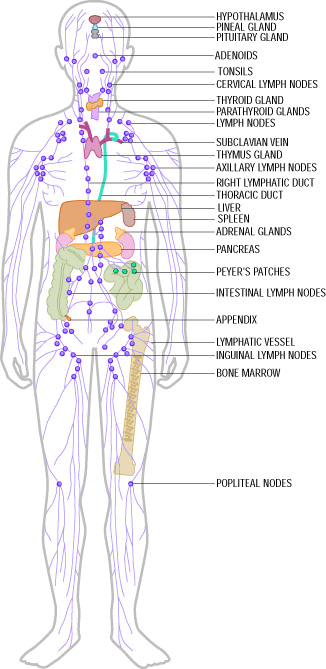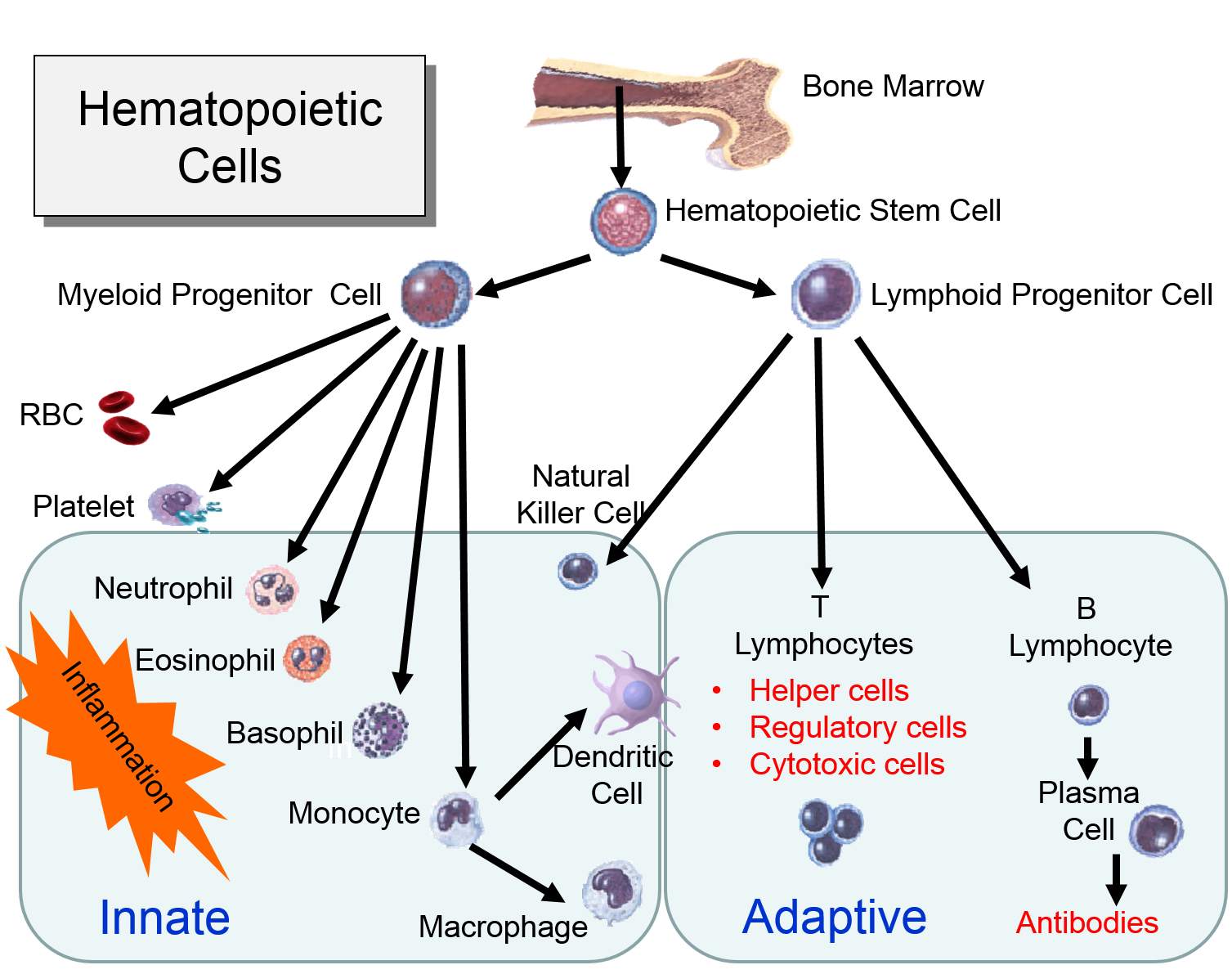Overview of Immunity
From a functional perspective, the immune system consists of innate immunity and adaptive immunity, two separate, but interacting and overlapping defensive systems that provide an additional array of defensive weapons. In addition, innate immunity and adaptive immunity are activated by recognition of molecular shapes that are "foreign" to our body. By distinguishing between "self" and "non-self" these systems are (normally) able to identify, destroy, and remove foreign cells, infectious agents, and large foreign molecules without directly attacking our own cells and tissues. [Note, however, that dysfunctional activation of our immune system sometimes has very harmful effects. See later sections on Recognition of "Self," Autoimmune Disease, and Cytokine Storm.]
Innate (Natural) Immunity
Many bacteria, viruses, and protozoa have glycoproteins and glycolipids
and glycolipids on their surface that have distinctive shapes (referred to as "pathogen-associated molecular patterns" or PAMPS) on their surface that enable them to be recognized in a non-specific way as "non-self" by the innate immune system. There are perhaps 100-200 of these PAMPs that have remained unchanged over the course of evolution, and they are molecular shapes that are not present in our tissues. The innate immune system has certain "sentinel cells (monocytes, macrophages, and specialized macrophages called a dendritic cells) that have so-called toll-like receptors that bind to PAMPs, triggering rapid cellular responses directed against the pathogens. The responses include:
on their surface that have distinctive shapes (referred to as "pathogen-associated molecular patterns" or PAMPS) on their surface that enable them to be recognized in a non-specific way as "non-self" by the innate immune system. There are perhaps 100-200 of these PAMPs that have remained unchanged over the course of evolution, and they are molecular shapes that are not present in our tissues. The innate immune system has certain "sentinel cells (monocytes, macrophages, and specialized macrophages called a dendritic cells) that have so-called toll-like receptors that bind to PAMPs, triggering rapid cellular responses directed against the pathogens. The responses include:
- Phagocytosis
 and intracellular killing by dendritic cells, monocytes, and macrophages.
and intracellular killing by dendritic cells, monocytes, and macrophages. - Recruitment of other inflammatory cells by secreting cytokines
 that activate other defensive cells and attract them to the site of invasion.
that activate other defensive cells and attract them to the site of invasion. - Communication with the adaptive immune system by presenting fragments of the pathogenic antigens
 to lymphocytes in order to activate them.
to lymphocytes in order to activate them. - Triggering an inflammatory response
- Triggering activation of the complement system

It is possible for a given PAMP to be present on a number of different types of pathogen, and the innate system will respond to them in the same way without distinguishing among them. Consequently, the innate system is non-specific in how it recognizes and responds to pathogens. And this system is referred to as innate or natural immunity, because the sentinel cells in the innate system will recognize a PAMP and respond to it on the first encounter.
These responses will be described in greater detail later in this module.
Adaptive (Acquired) Immunity
Cells of the lymphatic (or lymphoid) system provide adaptive immunity, which, unlike innate immunity, is highly specific in its ability to recognize and defend against specific foreign agents using both cellular weapons (e.g., cytotoxic T-lymphocytes) and humoral weapons (antibodies manufactured by plasma cells). The lymphatic system is distinct from the arterial and venous systems, but like them, it consists of a complex network of vessels (lymphatic ducts), and the distribution of the lymphatic network often runs in parallel with the arterial and venous systems. Along the lymphatic vessels, there are intermittent lymph nodes, which filter lymph and also house many defensive cells (leukocytes or "white blood cells") and provide a site where the various leukocytes can communicate with one another. When fighting an infection, nearby lymph nodes often become enlarged due to aggregation and increased production of leukocytes and and removal of foreign material. Filtered lymph eventually is emptied into the subclavian vein where it mixes with blood and contributes to the plasma fraction of blood. The thymus
due to aggregation and increased production of leukocytes and and removal of foreign material. Filtered lymph eventually is emptied into the subclavian vein where it mixes with blood and contributes to the plasma fraction of blood. The thymus and the spleen
and the spleen are also important components of the lymphatic system. The lymphatic system, thymus, and spleen play important roles in immune function, but cellular elements of the immune system are the real "soldiers" in the battle against foreign agents.
are also important components of the lymphatic system. The lymphatic system, thymus, and spleen play important roles in immune function, but cellular elements of the immune system are the real "soldiers" in the battle against foreign agents.

Source http://www.frequencyrising.com/immune_system.htm
Cells of the Innate and Adaptive Immune Systems
- The cells of the innate and adaptive immune systems originate in bone marrow where hematopoitic stem cells give rise to two lines of cells:
- Myeloid cells: These give rise to red blood cells, platelets, and the cells of the innate immune system.
- Lymphoid cells: These give rise to cells essential to adaptive immunity: T-lymphocytes, B-lymphocytes, and natural killer cells.
The illustration below shows the derivation of the key cells involved in the innate and adaptive immune systems.

Myeloid Cells of the Innate Immune System
(Point your cursor at each tab to see a brief description of each cell type.
 |
Roll over the tabs to view more information. |
|
This content requires JavaScript enabled.
|
|
Lymphoid Cells of the Adaptive Immune System)
 |
Roll over the tabs to view more information. |
|
This content requires JavaScript enabled.
|
|
The adaptive system differs from the innate system in several ways:
- It is slower to respond. Many cells of the innate system are present in tissues, and they react quickly to foreign agents. The adaptive immune cells are present in lymphatic organs and circulating in blood, and activation of the adaptive system requires a sequence of steps in order to create the highly specific clones needed to combat the foreign agent.
- It is highly specific, recognizing foreign shapes on a particular foreign agent; it even distinguishes, for example, between specific strains of influenza viruses. In contrast, the innate immune system recognizes broad categories of pathogens based on "pathogen-associated molecular patterns" or PAMPS)
- Once exposed to a specific foreign agent, the adaptive immune system develops immunologic "memory" (i.e., it adapts or "learns") which enables it to respond to subsequent infections with the same agent much more rapidly and vigorously. The innate system does not adapt in this way; each time a foreign agent breaches the skin or mucosal barriers, it responds promptly, but to the same extent as it did on previous occasions.



